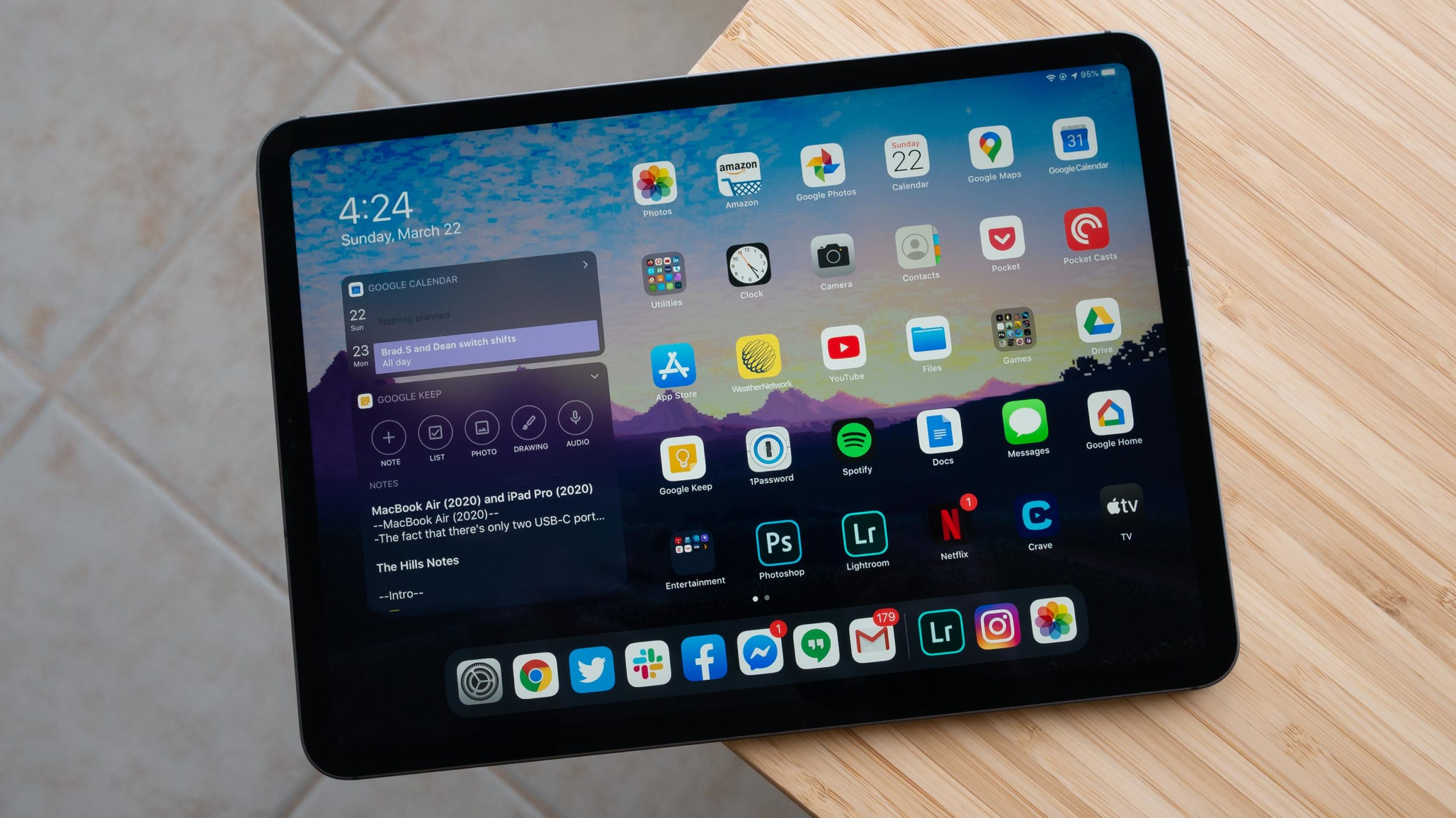
The Pros
- Extremely powerful
- LiDAR sensor holds tremendous potential for AR
- Mouse and trackpad cursor support is impressive
The Cons
- A12Z Bionic chip isn't much more poweful than the A12X
- Magic Keyboard with a trackpad is expensive
- Expensive after purchasing Apple Pencil and additional keyboard
Every iPad Pro review I’ve written has included one overarching theme: through a combination of hardware and software updates, the tablet-laptop hybrid device is slowly becoming a more viable laptop replacement.
That direction continues with Apple’s new 11-inch and 12.9-inch iPad Pro (2020).
The new iPad Pro, at least in some sense, is Apple admitting that Microsoft’s Surface Pro, with its keyboard, stylus and most importantly, trackpad, is the right way to approach a 2-in-1. This is an out of character, but welcome move on Apple’s part given its past reluctance to discuss the possibility of bringing cursor support to its long-running tablet line.
With the launch of the expensive iPad Pro ‘Magic Keyboard’ with a built-in trackpad (it’s also compatible with the 2018 iPad Pro), capable mouse and trackpad controls are finally an integral part of Apple’s tablet ten years into its existence thanks to iPadOS 13.4.

In the truest sense of the phrase, this is a case of ‘better late than never.’
Of course, there’s an inherent disconnect that stems from jumping between the iPad’s Smart Keyboard, the tablet’s touchscreen and a mouse or Apple’s Magic trackpad, that I’ll expand on in length later.
With all this in mind, the iPad Pro (2020) itself is nearly identical to its predecessor in several ways. It features a marginally more powerful A12Z Bionic Chip, minimized bezels and a single USB-C port. On the hardware side, the only significant upgrade this year is the dual camera array that’s capable of capturing images similar in quality to the iPhone 11 series, along with a light detection and ranging (LiDAR) sensor.

That being said, if you already own an iPad Pro (2018), or any of Apple’s recent iPads, you’ll also have access to nearly the same trackpad and mouse experience touted by the iPad Pro (2020).
In a way, the fact that the new iPad Pro’s most compelling feature is also included in nearly every device in Apple’s tablet lineup, makes this latest refresh a more difficult sell than its predecessor was at launch.
Note: This review is focused on the 11-inch iPad Pro (2020) as that’s the unit Apple sent to MobileSyrup. The 12.9-inch iPad Pro (2020) offers the same experience, but with a larger screen. I’ve spent the last few years using the 12.9-inch (2018) iPad Pro, and while I appreciate the additional display real-estate, the device is heavy and can at times feel unwieldy. I’d recommend only opting for the larger sized iPad Pro (2020) if you intend to use the tablet for work and really need the additional display space.
Update 04/20/2020: This review has been updated with impressions regarding the iPad Pro Magic Keyboard.
11-inch iPad Pro (2020)
11-inch iPad Pro (2018)
12.9-inch iPad Pro (2020)
12.9-inch iPad Pro (2018)
Display
11-inch IPS Liquid Retina display, 2388 x 1668 pixel resolution
11-inch IPS Liquid Retina display, 2388 x 1668 pixel resolution
12.9-inch IPS Liquid Retina display, 2048 x 2732 pixel resolution
12.9-inch IPS Liquid Retina display, 2,048 x 2,732 pixel resolution
Processor
Apple A12Z Bionic
A12X Bionic chip
Apple A12Z Bionic
A12X Bionic chip
RAM
6GB
4GB (6GB in the 1TB version)
6GB
4GB (6GB in the 1TB version)
Storage
128GB, 256GB, 512GB, 1TB
64GB, 256GB, 512GB, 1TB
128GB, 256GB, 512GB, 1TB
64GB, 256GB, 512GB, 1TB
Dimensions (in.)
247.6 x 178.5 x 5.9mm
247.6 x 178.5 x 5.9mm
280.6 x 214.9 x 5.9mm
280.6 x 214.9 x 5.9mm
Weight
471g
468g
641g
631g, 633g cellular
Rear Facing Camera
12-megapixel (f/1.8 aperture) + 10-megapixel (f/2.4 aperture), ToF
12.2-megapixel (f/1.8 aperture)
12-megapixel (f/1.8 aperture) + 10-megapixel (f/2.4 aperture), ToF
12-megapixel (f/1.8 aperture)
Front Facing Camera
7-megapixel (f/2.2 aperture)
7-megapixel (f/2.2 aperture)
7-megapixel (f/2.2 aperture)
7-megapixel (f/2.2 aperture)
OS
iPadOS 14
iOS 12
iPadOS 14
iOS 12
Battery
Built-in 36.71-watt-hour
Network Connectivity
Wi-Fi up to 802.11.ac, LTE (23 bands), Bluetooth 5.0, GSM / CDMA / HSPA / EVDO / LTE
Wi-Fi up to 802.11.ac, LTE (23 bands), Bluetooth 5.0, GSM / CDMA / HSPA / EVDO / LTE
Wi-Fi up to 802.11.ac, LTE (23 bands), Bluetooth 5.0, GSM / CDMA / HSPA / EVDO / LTE
Wi-Fi up to 802.11.ac, LTE (23 bands), Bluetooth 5.0, GSM / CDMA / HSPA / EVDO / LTE
Sensors
Face ID, Three axis gyro, Accelerometer, Ambient light sensor, Barometer
Face ID, Three axis gyro, Accelerometer, Ambient light sensor, Barometer
Face ID, Three axis gyro, Accelerometer, Ambient light sensor, Barometer
Face ID , Three axis gyro, Accelerometer, Ambient light sensor, Barometer
SIM Type
eSIM
eSIM
Nano SIM, eSIM
eSIM
Launch Date
March 18, 2020
November 7, 2018
March 18, 2020
November 7, 2018
Misc
Colours: Silver, Space Gray
Colours: Silver, Space Grey
Colours: Silver, Space Gray
Colours: Silver, Space Grey
Display
11-inch iPad Pro (2020)
11-inch IPS Liquid Retina display, 2388 x 1668 pixel resolution
11-inch iPad Pro (2018)
11-inch IPS Liquid Retina display, 2388 x 1668 pixel resolution
12.9-inch iPad Pro (2020)
12.9-inch IPS Liquid Retina display, 2048 x 2732 pixel resolution
12.9-inch iPad Pro (2018)
12.9-inch IPS Liquid Retina display, 2,048 x 2,732 pixel resolution
Processor
11-inch iPad Pro (2020)
Apple A12Z Bionic
11-inch iPad Pro (2018)
A12X Bionic chip
12.9-inch iPad Pro (2020)
Apple A12Z Bionic
12.9-inch iPad Pro (2018)
A12X Bionic chip
RAM
11-inch iPad Pro (2020)
6GB
11-inch iPad Pro (2018)
4GB (6GB in the 1TB version)
12.9-inch iPad Pro (2020)
6GB
12.9-inch iPad Pro (2018)
4GB (6GB in the 1TB version)
Storage
11-inch iPad Pro (2020)
128GB, 256GB, 512GB, 1TB
11-inch iPad Pro (2018)
64GB, 256GB, 512GB, 1TB
12.9-inch iPad Pro (2020)
128GB, 256GB, 512GB, 1TB
12.9-inch iPad Pro (2018)
64GB, 256GB, 512GB, 1TB
Dimensions (in.)
11-inch iPad Pro (2020)
247.6 x 178.5 x 5.9mm
11-inch iPad Pro (2018)
247.6 x 178.5 x 5.9mm
12.9-inch iPad Pro (2020)
280.6 x 214.9 x 5.9mm
12.9-inch iPad Pro (2018)
280.6 x 214.9 x 5.9mm
Weight
11-inch iPad Pro (2020)
471g
11-inch iPad Pro (2018)
468g
12.9-inch iPad Pro (2020)
641g
12.9-inch iPad Pro (2018)
631g, 633g cellular
Rear Facing Camera
11-inch iPad Pro (2020)
12-megapixel (f/1.8 aperture) + 10-megapixel (f/2.4 aperture), ToF
11-inch iPad Pro (2018)
12.2-megapixel (f/1.8 aperture)
12.9-inch iPad Pro (2020)
12-megapixel (f/1.8 aperture) + 10-megapixel (f/2.4 aperture), ToF
12.9-inch iPad Pro (2018)
12-megapixel (f/1.8 aperture)
Front Facing Camera
11-inch iPad Pro (2020)
7-megapixel (f/2.2 aperture)
11-inch iPad Pro (2018)
7-megapixel (f/2.2 aperture)
12.9-inch iPad Pro (2020)
7-megapixel (f/2.2 aperture)
12.9-inch iPad Pro (2018)
7-megapixel (f/2.2 aperture)
OS
11-inch iPad Pro (2020)
iPadOS 14
11-inch iPad Pro (2018)
iOS 12
12.9-inch iPad Pro (2020)
iPadOS 14
12.9-inch iPad Pro (2018)
iOS 12
Battery
11-inch iPad Pro (2020)
11-inch iPad Pro (2018)
12.9-inch iPad Pro (2020)
12.9-inch iPad Pro (2018)
Built-in 36.71-watt-hour
Network Connectivity
11-inch iPad Pro (2020)
Wi-Fi up to 802.11.ac, LTE (23 bands), Bluetooth 5.0, GSM / CDMA / HSPA / EVDO / LTE
11-inch iPad Pro (2018)
Wi-Fi up to 802.11.ac, LTE (23 bands), Bluetooth 5.0, GSM / CDMA / HSPA / EVDO / LTE
12.9-inch iPad Pro (2020)
Wi-Fi up to 802.11.ac, LTE (23 bands), Bluetooth 5.0, GSM / CDMA / HSPA / EVDO / LTE
12.9-inch iPad Pro (2018)
Wi-Fi up to 802.11.ac, LTE (23 bands), Bluetooth 5.0, GSM / CDMA / HSPA / EVDO / LTE
Sensors
11-inch iPad Pro (2020)
Face ID, Three axis gyro, Accelerometer, Ambient light sensor, Barometer
11-inch iPad Pro (2018)
Face ID, Three axis gyro, Accelerometer, Ambient light sensor, Barometer
12.9-inch iPad Pro (2020)
Face ID, Three axis gyro, Accelerometer, Ambient light sensor, Barometer
12.9-inch iPad Pro (2018)
Face ID , Three axis gyro, Accelerometer, Ambient light sensor, Barometer
SIM Type
11-inch iPad Pro (2020)
eSIM
11-inch iPad Pro (2018)
eSIM
12.9-inch iPad Pro (2020)
Nano SIM, eSIM
12.9-inch iPad Pro (2018)
eSIM
Launch Date
11-inch iPad Pro (2020)
March 18, 2020
11-inch iPad Pro (2018)
November 7, 2018
12.9-inch iPad Pro (2020)
March 18, 2020
12.9-inch iPad Pro (2018)
November 7, 2018
Misc
11-inch iPad Pro (2020)
Colours: Silver, Space Gray
11-inch iPad Pro (2018)
Colours: Silver, Space Grey
12.9-inch iPad Pro (2020)
Colours: Silver, Space Gray
12.9-inch iPad Pro (2018)
Colours: Silver, Space Grey
Identical look
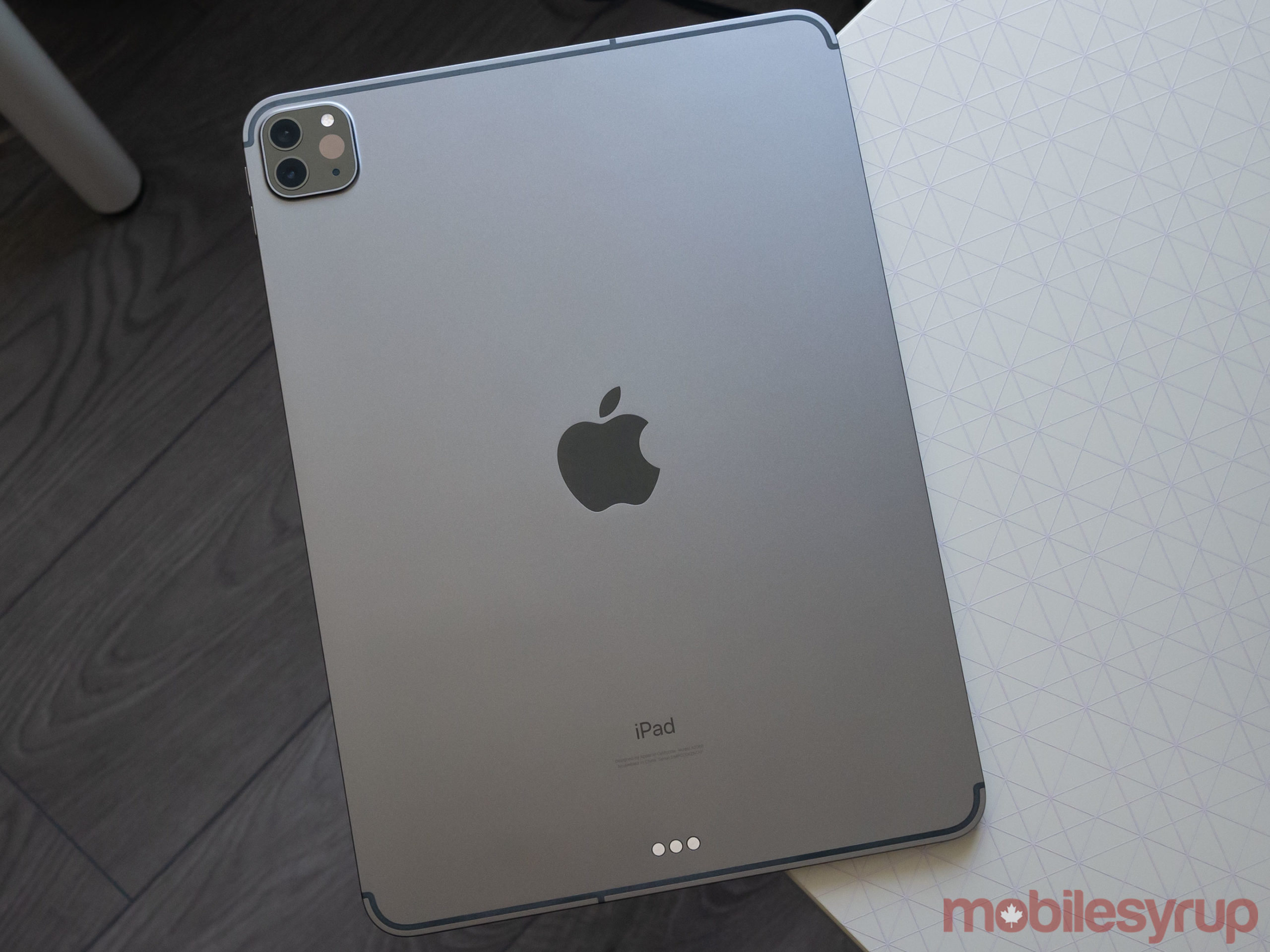
Placing the new iPad Pro beside its 2018 predecessor reveals no perceivable differences between the tablets’ looks.
The new iPad Pro still comes in 11-inch and 12.9-inch display sizes. The edge-to-edge Liquid Retina display, with P3 wide colour and excellent 120Hz scrolling and responsiveness, also returns.
The tablet features the same squared-off design with rounded corners, adding further fuel to the rumours that Apple’s next flagship iPhones will adopt a similar aesthetic.
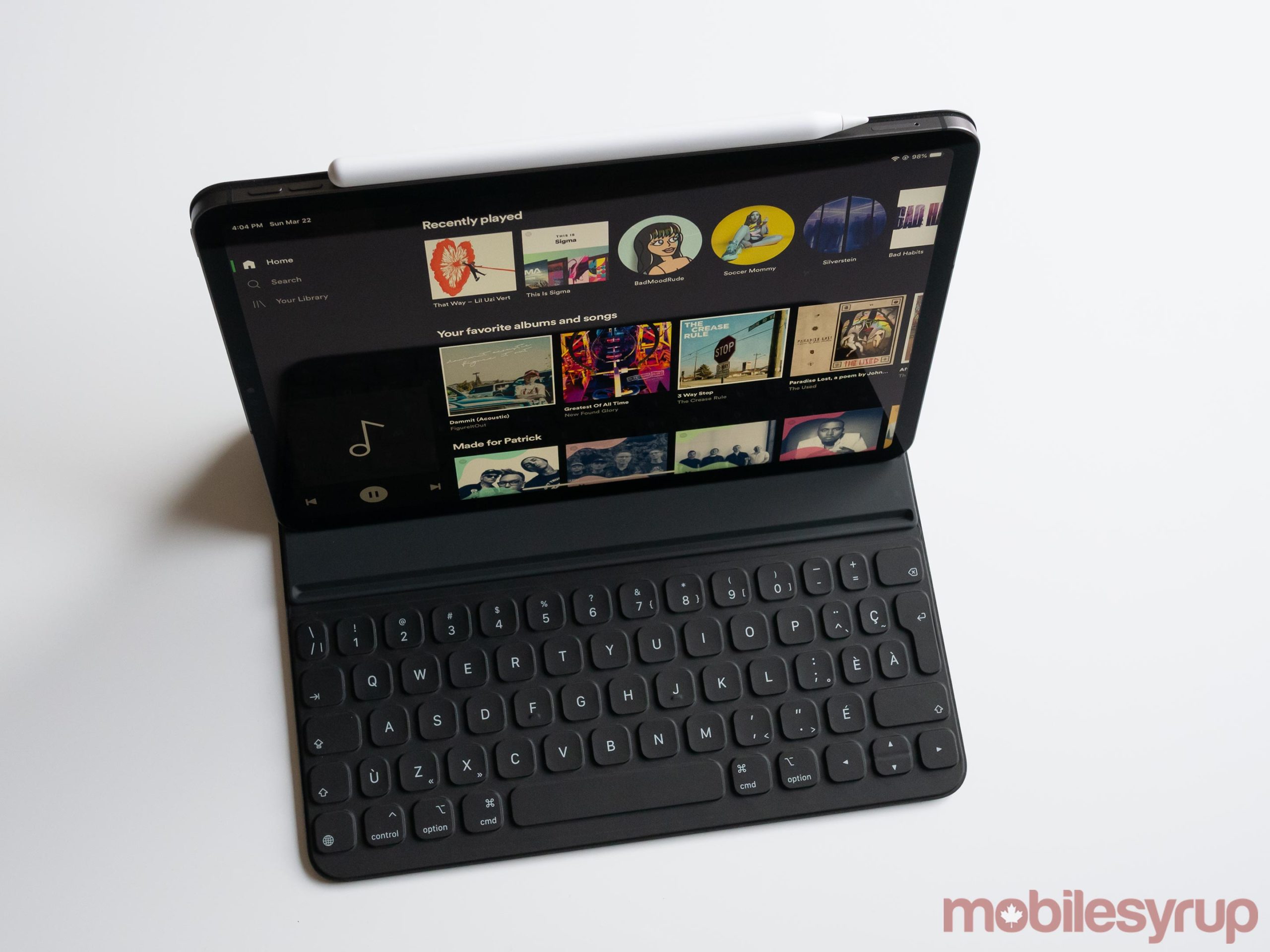
The only noticable difference this year looks-wise is the addition of a dual-rear camera bump. The aesthetic of the bulge is very similar to the iPhone 11’s camera array. There’s a substantial camera bump housing the pair of new lenses that also stick out, along with a flash and the new LiDAR sensor.
I like the look of the camera bump; it feels premium and is sleek. Some people may take issue with the fact that the iPad Pro can’t sit flat on a table anymore, but I didn’t find this to be a problem.
Apart from the addition of a new camera array, the new iPad Pro looks, weighs and feels nearly identical to its predecessor.
LiDAR holds exciting potential
Along with an improved camera array, the iPad also includes a new LiDAR scanner. This gives the tablet’s shooters an improved understanding of depth, allowing the iPad Pro to measure large objects better and feature upgraded object occlusion. The sensor does this by measuring distance based on how long it takes light to reach an object and reflect back. For context, the sensor is capable of reflecting light on an object up to 5 metres away.
Regarding object occlusion specifically, thanks to the LiDAR sensor, augmented reality experiences should be able to pass behind and in front of real-world objects more realistically. This, at least in theory, makes the strange clipping that often occurs with current augmented reality apps a thing of the past. Finally, the sensor also allows the tablet to more accurately and quickly measure the surfaces in a room, including the floor, walls, door and windows.
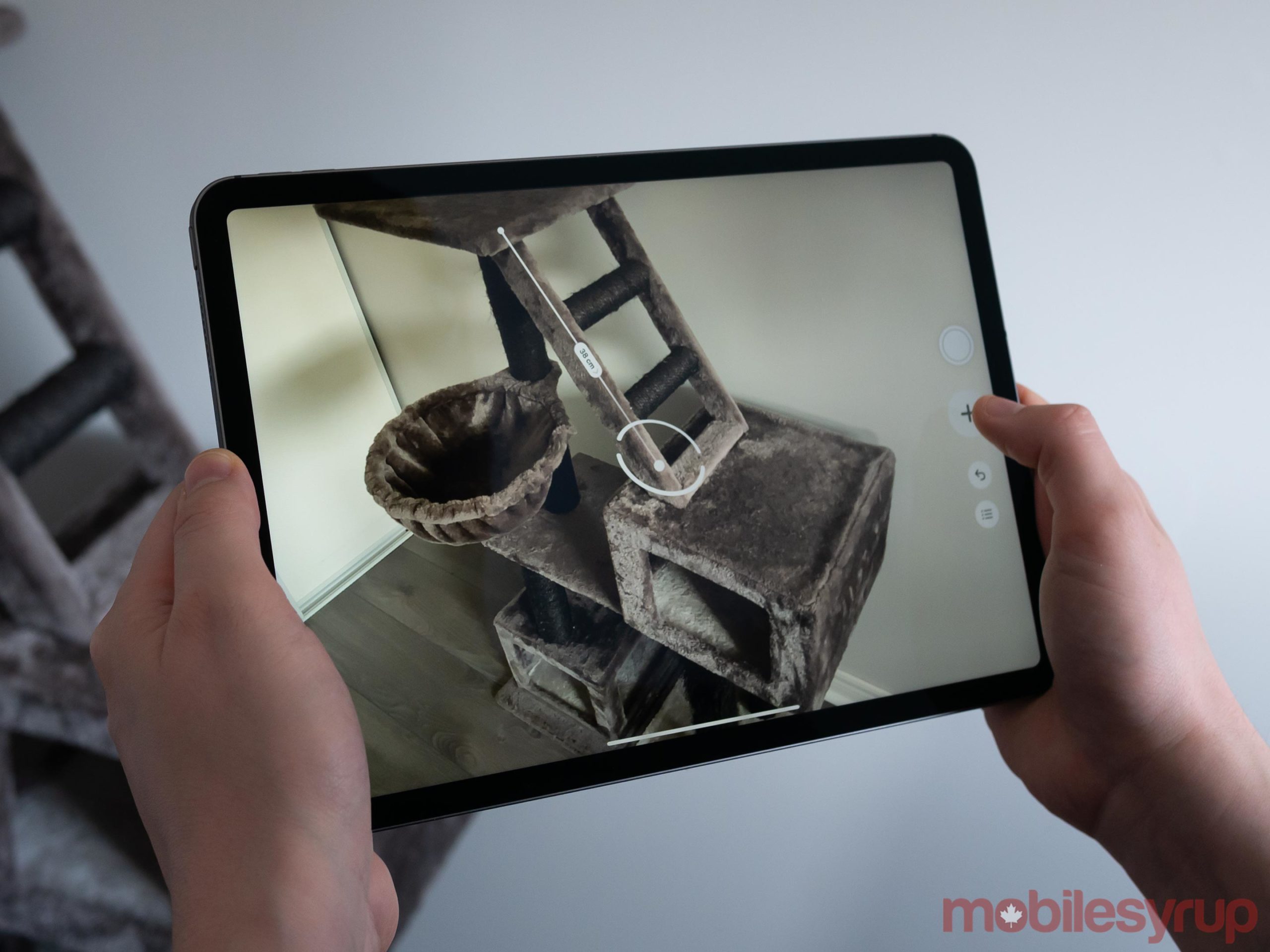
The real-world result is that all AR apps automatically perform more accurately and consistently. The difference isn’t immediately noticeable with most apps right now, but Apple’s Measure app does feel more accurate, especially under low-light.
Apple’s AR push still lacks the killer app that will convince the masses to take the technology seriously. But adding a LiDAR sensor to the iPad Pro gives developers the tools to potentially create that app. Similar to the addition of mouse support (more on this later), the new LiDAR sensor lays the groundwork for developers to do something interesting.
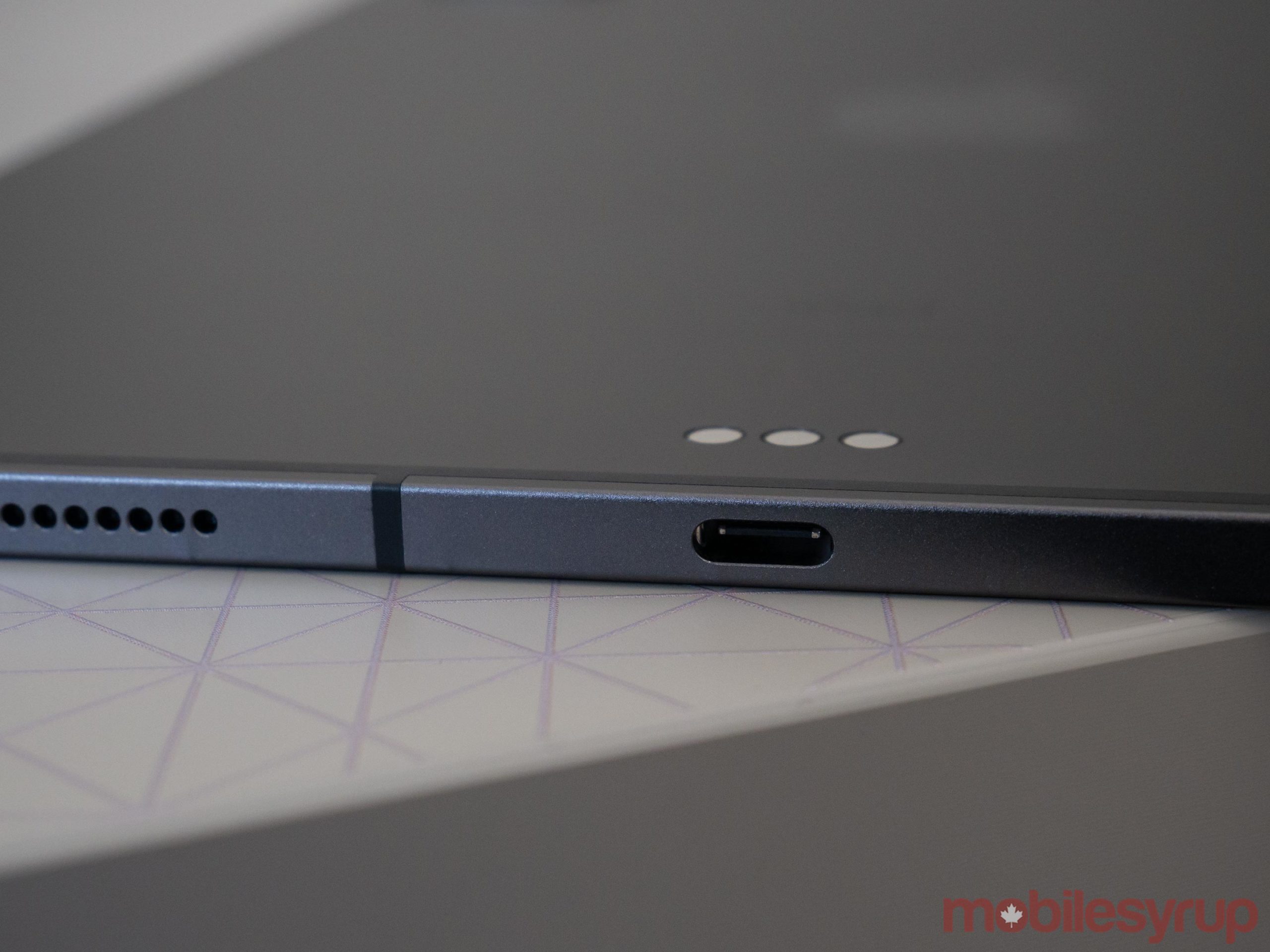
What remains to be seen is if third-party app developers will end up taking advantage of the technology.
The rest of the hardware

What’s most disappointing about the iPad Pro (2020) is its A12Z Bionic chip is only slightly more powerful than the already impressive A12X processor. It’s strange Apple opted to upgrade 2018’s A12X chip rather than include a faster version of the iPhone 11’s A13 processor. In fact, the margin of improvement is so low that the 11-inch iPad Pro (2018) comes in at 1,117 on Geekbench in a single-core score, compared to 1,111 with its A12X-equipped predecessor.
However, the multicore results show a more significant improvement, with the new 11-inch iPad Pro coming in at 4,704 and 4,604 for the 2018 iPad Pro. Though an increase in power, there’s usually a more substantial jump when it comes to Apple’s iPhone and iPad releases. However, if you’re moving from the A10X Fusion chip in Apple’s 10.5-inch iPad Pro from back in 2017, the A12X offers 2.6 times faster performance.
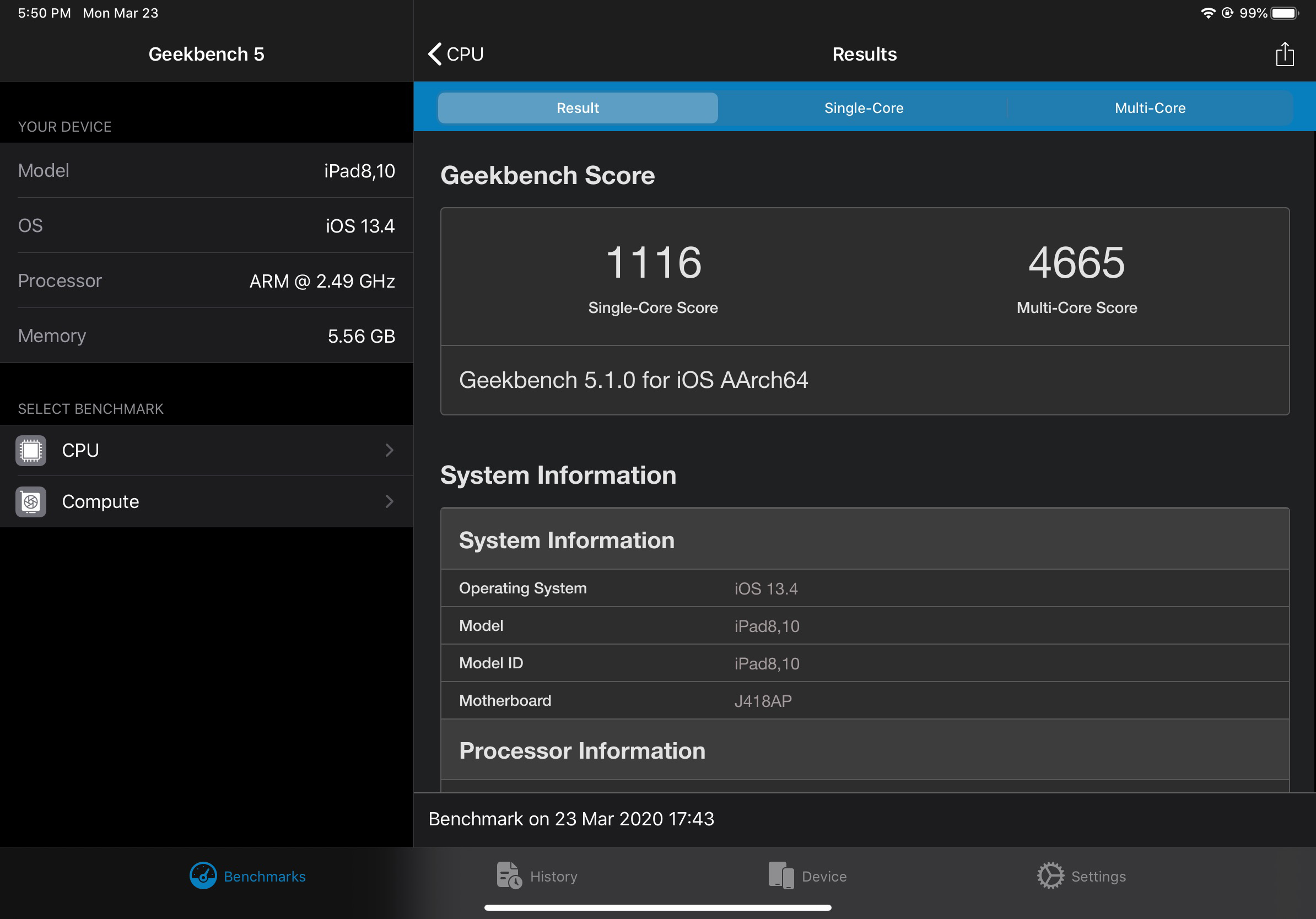
Though the inclusion of better cameras relates more to the iPad Pro’s AR functionality, Apple’s high-end tablet is now finally capable of snapping great photographs somewhat comparable to what the iPhone 11 shoots. The iPad Pro (2020) features a 12-megapixel f/1.8 aperture wide camera capable of shooting 4K video at 60fps, coupled with a 10-megapixel f/2.4 ultra-wide shooter that captures a wider field-of-view, and can also shoot 4K. Other features borrowed from the iPhone include Smart HDR, Portrait Mode and a quad-LED True Tone flash. The iPad Pro, however, doesn’t feature the iPhone 11’s Night Mode.
All of these improvements are welcome given the iPad’s camera array has been lagging behind the iPhone for the last few years. However, I doubt many people are actually snapping photos with the tablet given its size makes it awkward to carry around and use as an on-the-go camera. Still, in the off chance you need to capture a special family moment and only have the iPad Pro around, it’s good to know the tablet is finally capable of good photography.
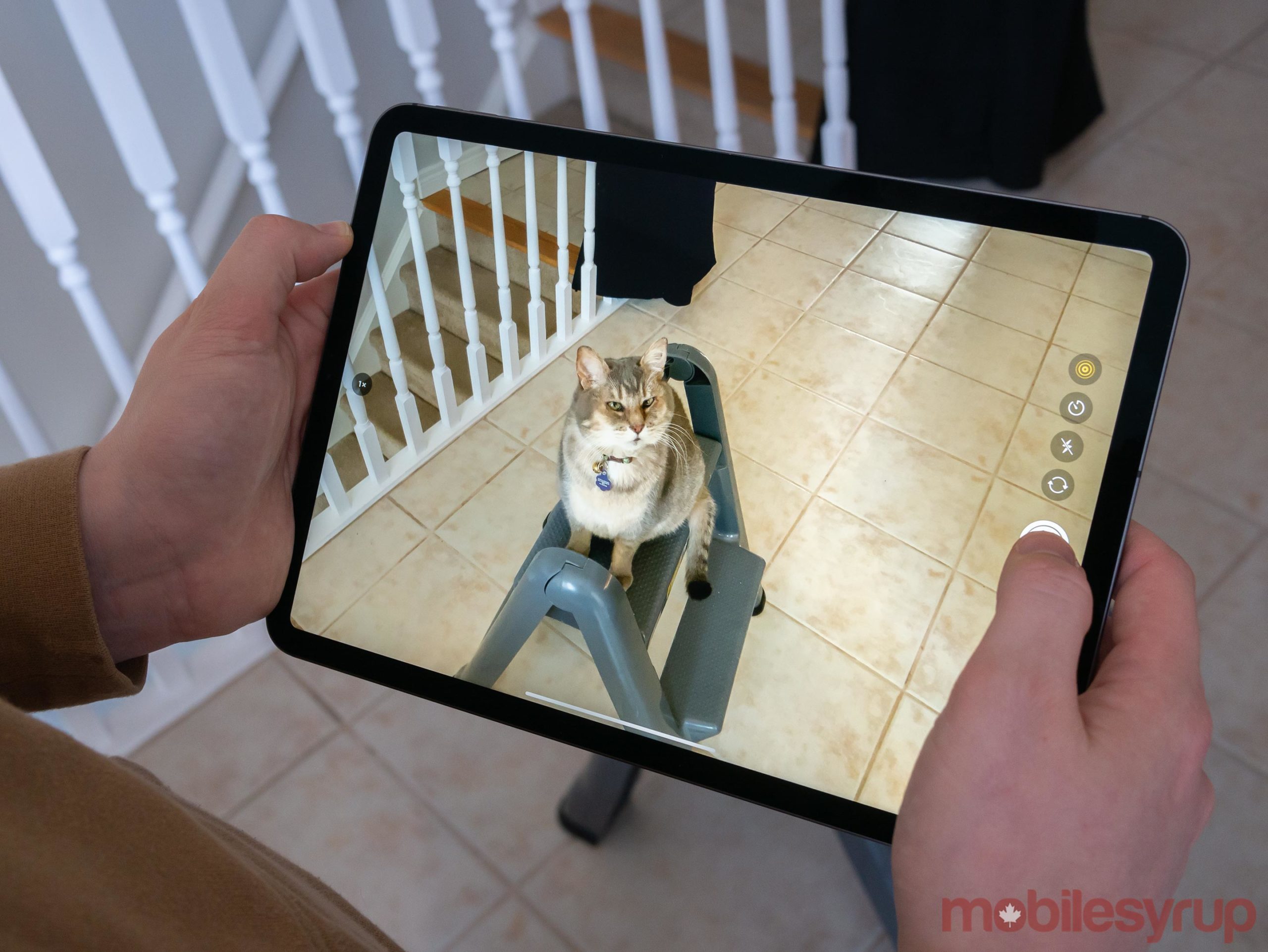
On the front, the 7-megapixel f/2.2 TrueDepth camera system returns and is just as excellent as the shooter featured in the new iPad Pro’s predecessor. Face ID works from more angles, including when the tablet is sitting on a desk. In fact, I wish the iPhone 11 and 11 Pro Max featured the same TrueDepth camera array as the iPad given how accurate and consistent it is.
The 2nd-generation Apple Pencil is also back with the new iPad Pro. The stylus still switches tools with a quick tap and can attach to the top of the tablet magnetically to charge and store. If you found Apple’s stylus useful in the past, that’s not going to change with the new iPad Pro. I, on the other hand, still don’t have much use for the Apple Pencil beyond spot removal with Adobe’s Lightroom CC.

The single USB-C port that was such a game-changer with the iPad Pro (2018) is back as well. Part of me wishes the tablet featured more than one USB-C port, especially given you can now use it with a mouse or trackpad, but this issue can easily be solved with a relatively low-cost USB-C dongle.
Other features include all-day battery life, four speakers, better quality microphones, Wi-Fi 6 support, Gigabit Class LTE, eSIM support, Bluetooth 5.0 and a magnetic Smart Connector. There’s also still not a 3.5mm headphone jack, just like the 2018 iPad Pro.
The trackpad question
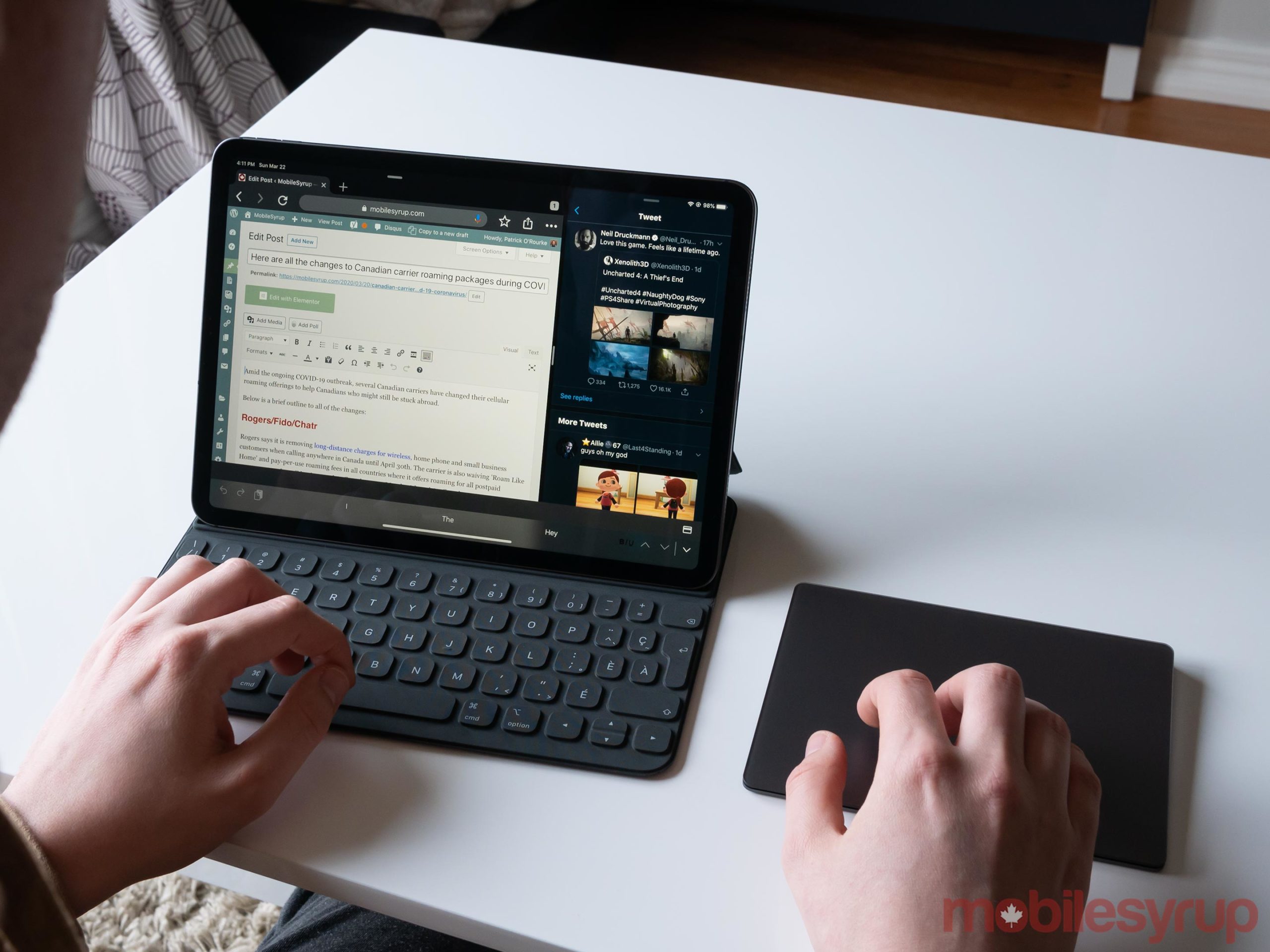
iPadOS 13.4’s trackpad support is a long time coming as it brings comprehensive contextual cursor functionality to the iPad for the first time. The cursor appears on-screen as a circle and transforms contextually based on the tool you’re using. For example, the cursor adapts to app icons on the Home screen, Dock buttons and text, complete with the same text editing features anyone who has used macOS or Windows will be accustomed to.
There are also several familiar macOS trackpad gestures, including the three-finger swipe up to return to the Home screen, swipe up with a pause to switch between apps, right-clicking with two fingers and several more.
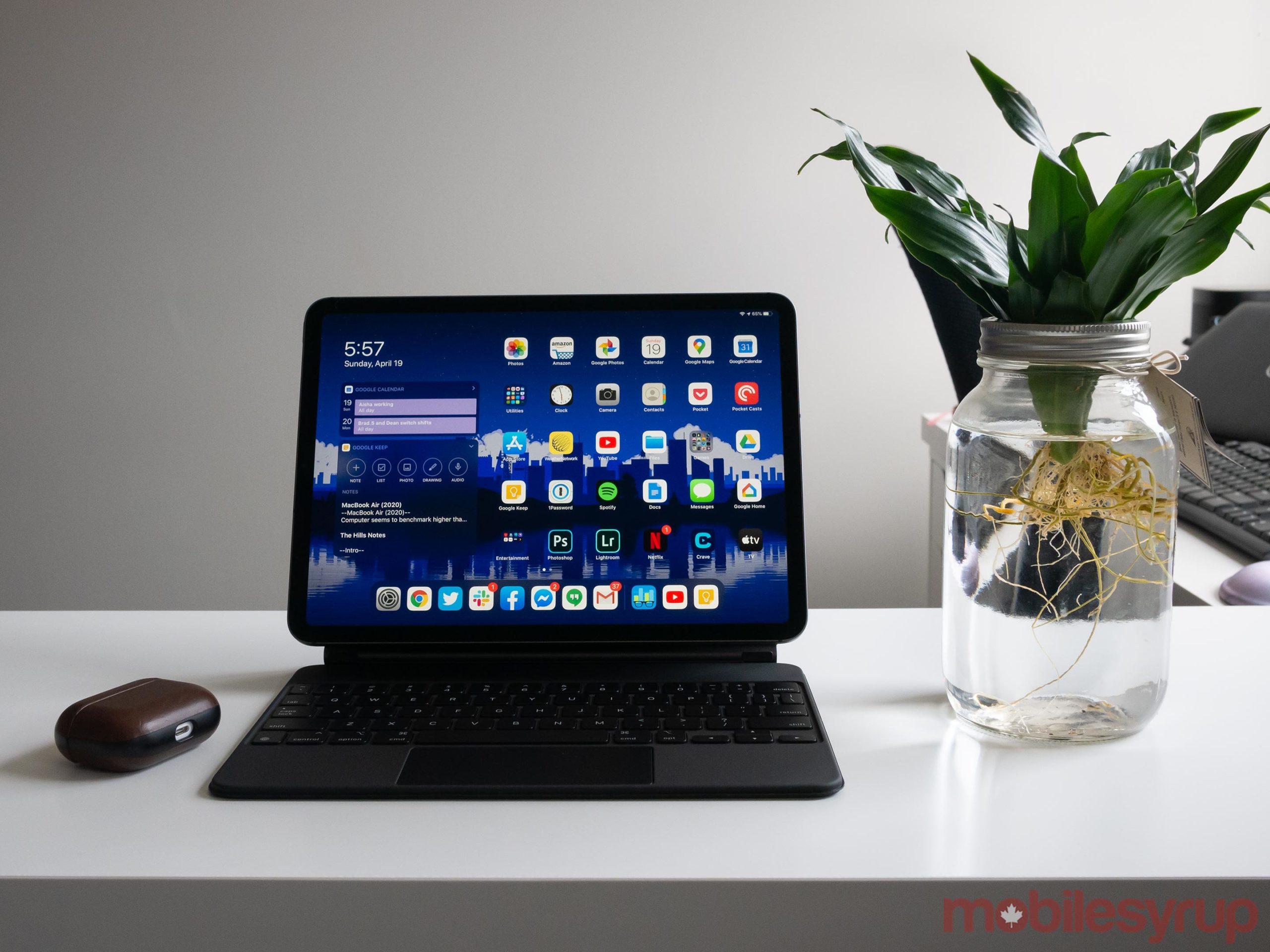
Even if you don’t intend to use the cursor support very often, navigating with gestures feels great and will feel natural to anyone who uses macOS.
If you’re using a standard mouse and not Apple’s Magic Trackpad or Magic Mouse, you won’t be able to use gestures. I spent a few hours using Logitech’s M720 Triathlon Multi-Device Wireless Mouse, and I’d compare the experience to feeling like I was working with one hand behind my back. Mouse support is great, but the addition of keyboard gestures ties the entire experience together.

It’s also important to point out that while iPadOS’ new cursor support is surprisingly fluid and responsive — especially considering few apps have been updated with direct support for the feature — it’s not perfect yet. For example, with Lightroom CC, I found I wasn’t consistently able to navigate through my photo library (it worked sometimes, but not always). I also couldn’t click on settings and add specific values when editing a photo in Lightroom. In Excel, you can’t shift and click on an entire cell.
Similar strange navigation instances can be found in nearly every iPadOS app. This will likely change as third-party developers adapt their user interfaces with mouse and trackpad support in mind. I also expect this shift to happen relatively quickly.
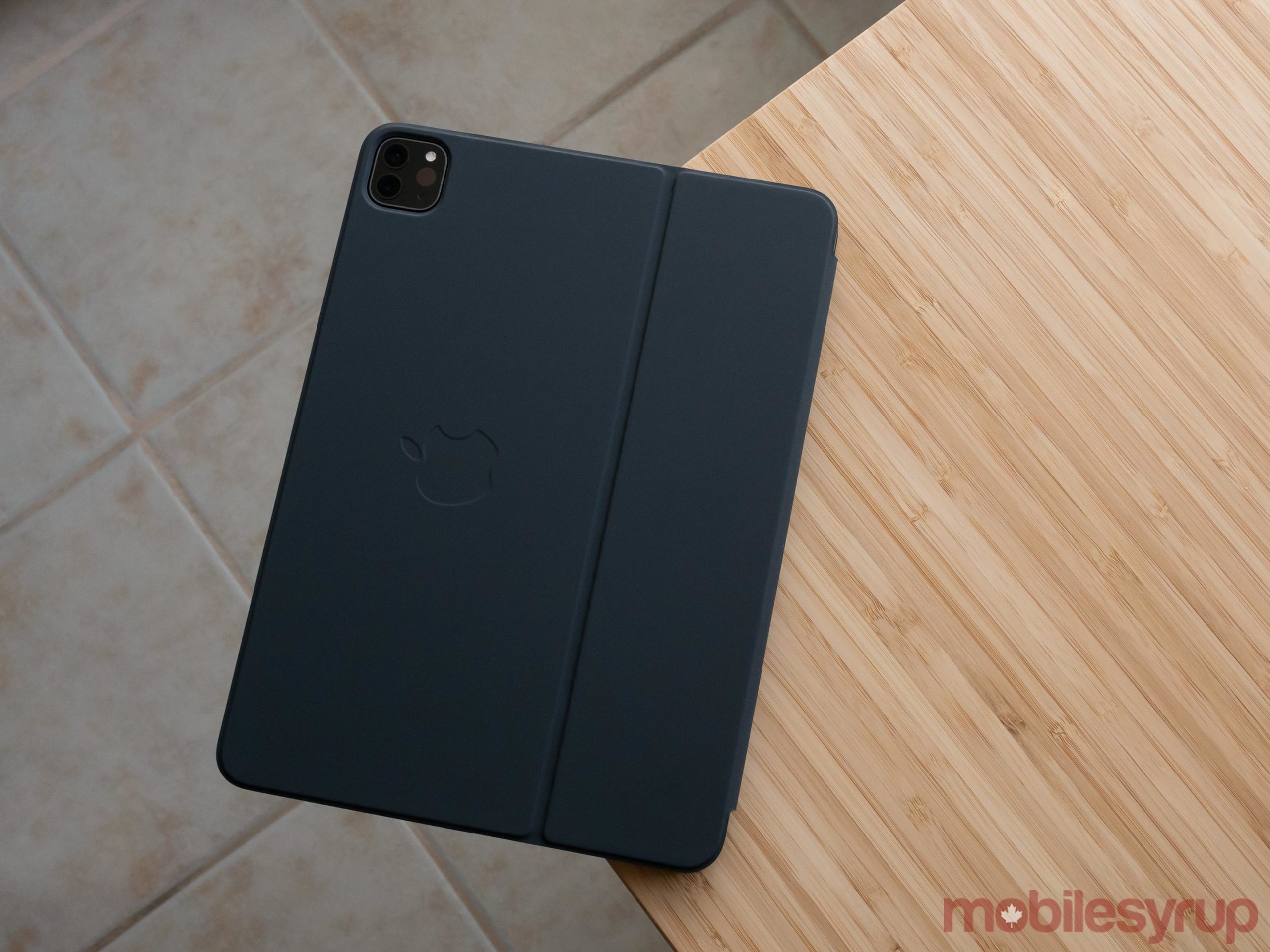
There’s a bit of a disconnect when using the Magic Trackpad with the iPad Pro. For one, no one wants to carry around a trackpad when on-the-go. Also, not having your hands on the keyboard at all times can get bothersome if you’re using the iPad Pro for long periods.
This issue is solved by the excellent but expensive Magic Keyboard (starting at $399 CAD). The new backlit keyboard features hard keycaps, a scissor key mechanism very similar to the Smart Keyboard included in the new MacBook Air (2020) and 16-inch MacBook Pro, and 1mm of key travel.
The Magic Keyboard’s hinge is also capable of adjusting between 90-and 130-degrees, solving the limited angle issue the current iPad Pro Smart Keyboard suffers from. Other features include USB-C pass-through for charging, giving the tablet the much-needed second USB-C port I mentioned earlier.
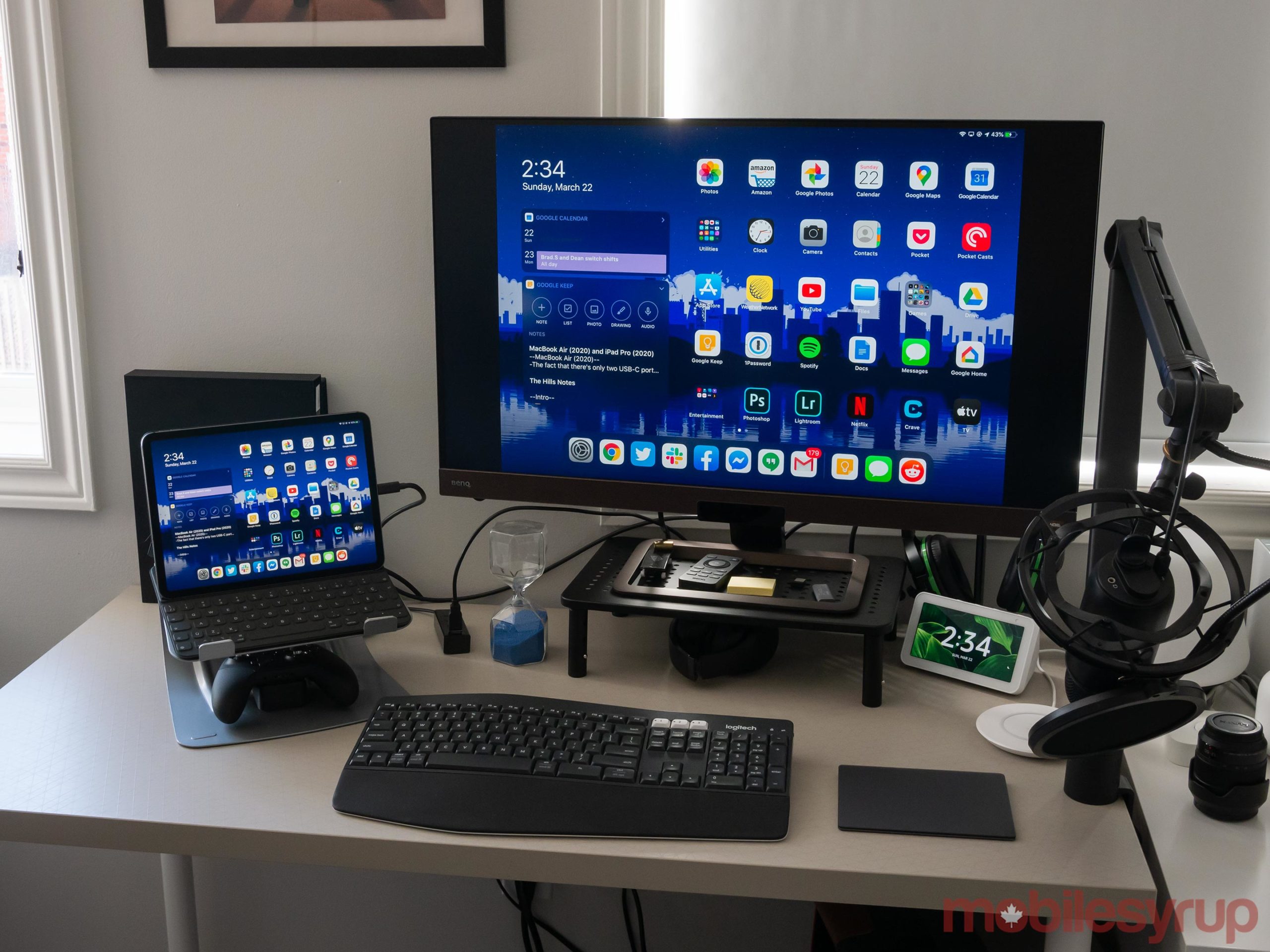
Most importantly, the Magic Keyboard features a built-in trackpad.
The keyboard is surprisingly solid even when using it on my lap, and most importantly, it allows you to actually adjust the iPad Pro’s angle to more than two positions, unlike the tablet’s not very good Smart Keyboard.

It’s worth keeping in mind that it’s likely third-party manufacturers (especially Logitech) will release more affordable, possibly just as good or even better keyboard options in the coming months, because there’s no getting around the fact that the Magic Keyboard is extremely pricey. For more on the Magic Keyboard, check out my in-depth look at the keyboard.
On a side note, the new iPad Pro Smart Keyboard is identical to its predecessor. The colour is slightly darker, and there’s now a logo on the rear of the folio portion. The keys and overall folio design are the same, so if you weren’t fond of Apple’s previous iPad Pro Smart Keyboards, this one isn’t going to change your mind.
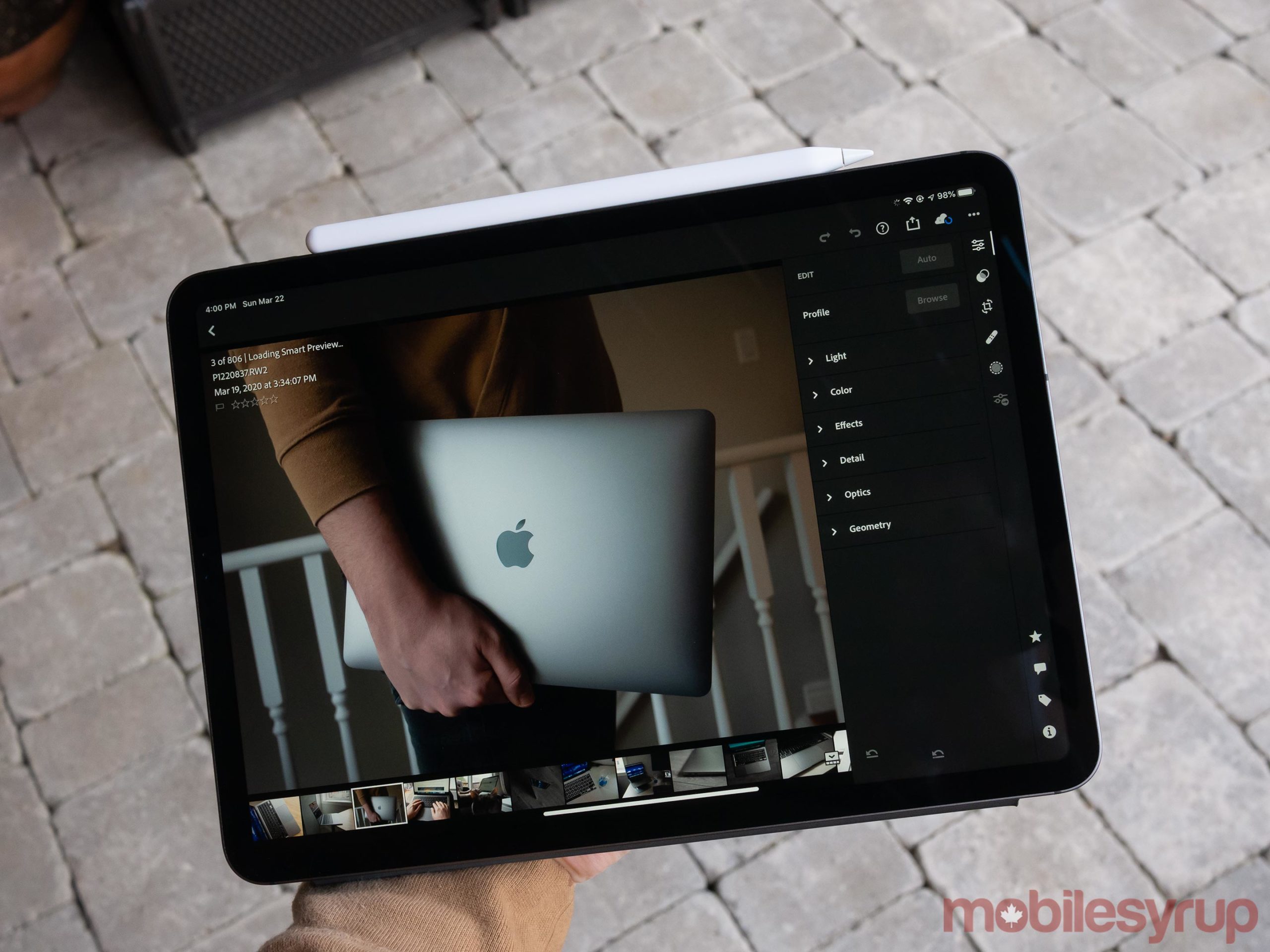
It's nearly ready
Given how seemingly effortlessly Apple added comprehensive cursor support to the iPad, it's baffling it took the company this long to finally bring the navigation method to its tablet line. Though we'll likely never know for sure, the much-needed changes we've seen to Apple's products over the last few months likely have something to do with Jony Ive, Apple's former chief design officer, departing from the company last year.
The main takeaway from my experience with the 2020 iPad Pro is the tablet is truly almost ready to be a laptop replacement for most people as long as one key thing happens.
Third-party apps need to be swiftly updated with more full-fledged cursor support.
Even then, the inherent nature of iPadOS will likely still require workarounds to perform some everyday tasks. This means that despite Apple's best efforts, the tablet can't be a laptop replacement for everyone. For instance, if I were to switch to using an iPad Pro entirely to do my job, Adobe would need to update all of its apps with more expansive trackpad support. Since I've used two monitors for nearly a decade and find it integral to my workflow, I'd also need dual-screen support from the iPad Pro (right now, you can only mirror the iPad Pro's display on a secondary screen).
Given iPadOS has forked off from iOS, changes like this could arrive with the next version of the tablet operating system.
The 11-inch iPad Pro (2020) with 128GB of storage starts at $1,049, with the 12.9-inch version coming in at $1,299. The tablet is available in both 'Space Grey' and 'Silver.'
"Capable mouse and trackpad controls are finally an integral part of Apple's tablet ten years into its existence"
MobileSyrup may earn a commission from purchases made via our links, which helps fund the journalism we provide free on our website. These links do not influence our editorial content. Support us here.



